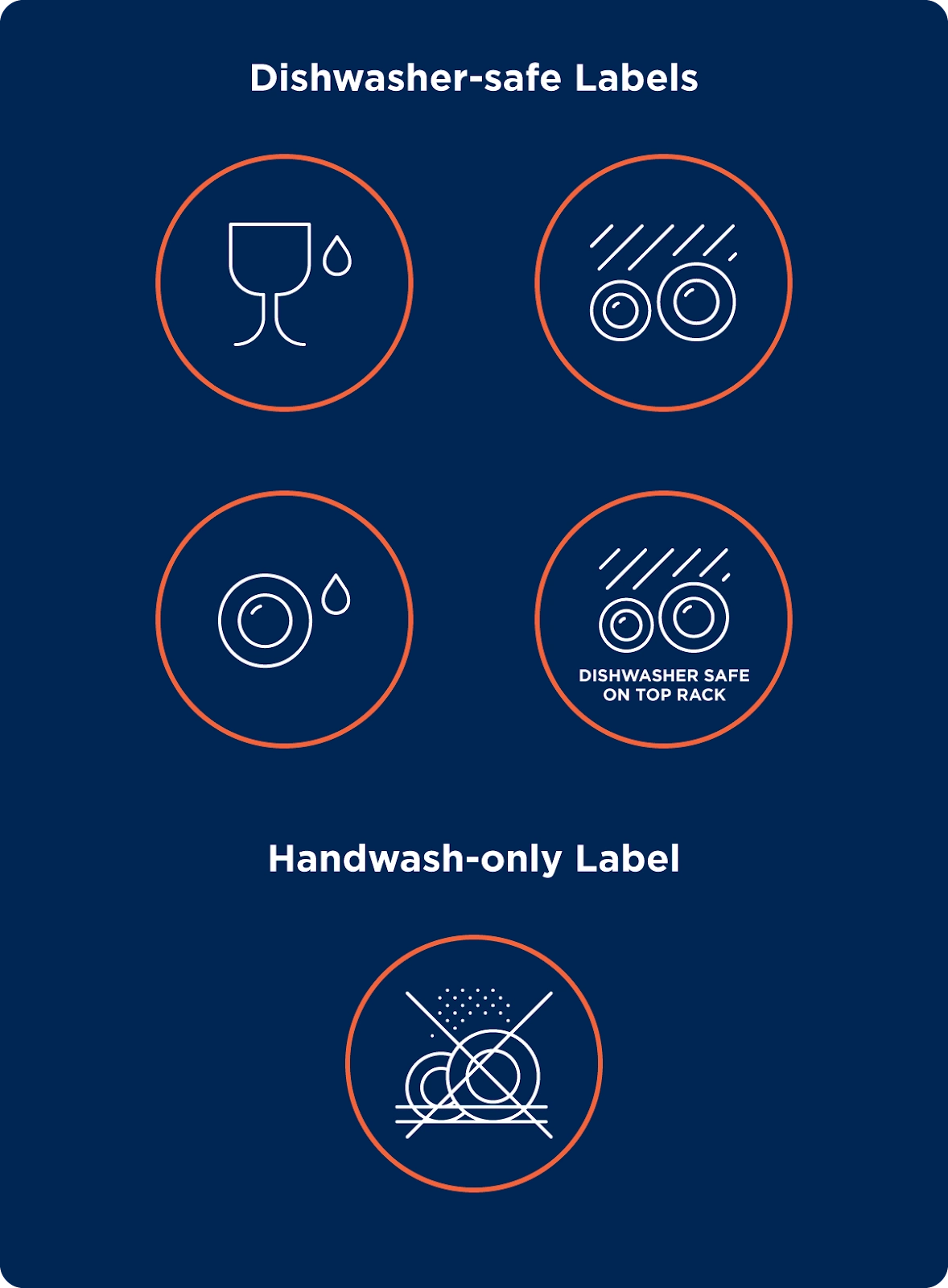Can You Put Baby Bottles in the Dishwasher?
.webp)
|
You can put bottles in the dishwasher for convenient and effective cleaning — just make sure to follow the manufacturer's guidelines for dishwasher-safe materials and proper disassembly for best results. |
Caring for a baby is a full-time job, and no one will blame busy parents for wanting to take all the shortcuts they can. From diaper changes to round-the-clock feeding, time is at a premium, which raises the question: Can you put bottles in the dishwasher?
The short answer is yes, you can wash most baby bottles in a dishwasher. However, there are some extra steps to take to ensure they’re thoroughly cleaned and sanitized. Read on to learn the most effective way to clean your bottles while saving yourself precious time and energy.
1. Read the Labels
Before tossing your baby bottles into the dishwasher, you need to make sure they’re dishwasher safe. Using non-compatible bottles in the dishwasher may lead to warping, degradation, or melting, compromising the bottle's functionality and longevity.
Most baby bottles are equipped with symbols that provide important information about their dishwasher compatibility. Your baby bottles might have a “dishwasher safe” text label on the bottom, or they may have one of these dishwasher symbols:
- A square with a cup and fork icon inside
- A square with a wine glass and water droplets inside
- A plate or several dishes with water droplets or dotted lines above
If your bottles have a crossed-out dishwasher icon, it means they’ll need to be handwashed. You can check the manufacturer’s website for specific care instructions if you’re unsure about your bottle care requirements.

2. Rinse the Bottles
To ensure your bottles are thoroughly cleaned, rinse them in warm water to remove any residual milk or formula before placing them in the dishwasher.
Rinsing not only enhances the dishwasher's cleaning efficiency but also prevents the formation of dried-on residue that could harbor bacteria if not addressed. This simple yet essential step ensures that the dishwasher can focus on sanitizing the bottles rather than removing stubborn, dried substances for a more hygienic cleaning process.
3. Disassemble
After rinsing your bottles, you need to disassemble them so each nook and cranny is properly cleaned. This typically includes taking apart:
- Bottle caps
- Nipples
- Bottle rings
- Any other small parts or valves that are part of the bottle's design
Disassembling the bottle exposes each component to the dishwasher's thorough cleaning action, ensuring no hidden areas retain milk or formula residue. However, certain bottle parts, such as nipples and valves, may require a gentler cleaning approach if specified in the care instructions. Washing these smaller components by hand with warm, soapy water and allowing them to air-dry separately can help maintain their integrity and prevent damage.
4. Place in a Basket or Mesh Bag
After disassembling all components, place the smaller parts in a designated basket or mesh bag before running them through the dishwasher.
This step will keep all the smaller components together, preventing them from getting lost in the dishwasher or falling through the racks, which can lead to incomplete cleaning or damage. Washing your bottle parts in a basket or mesh bag will also help protect delicate parts like bottle nipples from potential damage if placed directly on the dishwasher rack.
5. Ensure Proper Placement
Disassembled baby bottles should be placed facing down on the top rack of the dishwasher. This placement prevents exposure to direct heat at the bottom of the dishwasher, which could potentially damage the bottles or compromise the integrity of the materials, especially if they are made of plastic.
Additionally, placing the bottles face down allows water to drain away from the interior, ensuring any remaining detergent or water residue doesn't collect inside the bottles. This placement also enables the water jets to reach the interior more effectively, providing optimal cleaning coverage.
6. Select the Right Cycle
You may need to adjust your go-to dishwasher setting when washing baby bottles. If your dishwasher offers a sanitizing cycle, use it for baby bottle cleaning. The sanitizing cycle employs higher temperatures, often reaching around 150°F (65.6°C) or higher, which helps eliminate bacteria and ensures a more thorough disinfection of the bottles.
If a sanitizing cycle is not available, opt for a normal or heavy cycle. These cycles typically involve extended wash times and higher temperatures than lighter cycles, ensuring a proper clean. Consult your dishwasher's manual to understand the specific details of each cycle.
7. Use Baby Bottle-Friendly Detergent
Not all detergents are created equal, and some may contain harsh chemicals or fragrances that can leave potentially harmful residue on your bottles.
When shopping for detergents, look for ones that are:
- Mild
- Fragrance-free
- Preferably pediatrician-approved
These detergents are gentle yet effective in eliminating bacteria and residues without leaving harmful chemicals behind.
Before using any detergent, check the label to make sure it’s suitable for cleaning baby bottles. Look for indications such as "baby bottle safe," "pediatrician recommended," or any similar endorsements.
8. Look for Residue
After running your dishwasher, take the time to inspect each baby bottle for leftover residue.
Despite the dishwasher's efficiency, water hardness or certain detergent may lead to cloudy dishes and residue. If you notice any leftover milk remnants, consider rerunning the bottles through another dishwasher cycle or handwash for a more targeted approach. You should also follow proper dishwasher maintenance to keep your appliance at its best.
If residue continues to be a problem when washing your bottles in the dishwasher, there may be an issue with your appliance. In this case, consider consulting a professional for dishwasher servicing.
9. Dry and Store the Bottles
The final step in cleaning your baby bottles is to ensure proper drying and storage. While the dishwasher effectively cleans and sanitizes the bottles, residual moisture can lead to bacterial growth. Thorough drying is crucial to eliminate moisture and maintain the cleanliness of the bottles.
After the dishwasher cycle, allow the disassembled bottles to air-dry completely on a clean, dry surface. Placing them upside down on a drying rack allows any remaining water droplets to drain away from the inside of the bottle. Avoid towel-drying as this could contaminate the inside of the bottles.
Once your bottles are totally dry, you can put them away. Consider the following tips for proper storage:
- Ensure bottles are completely dry before storing them to prevent bacterial growth.
- Store bottles with the lids loosely attached or upside down to allow for ventilation and discourage mold.
- Use a designated clean area to store the bottles to prevent potential contamination.
- Avoid storing bottles near cleaning supplies or other potential sources of contaminants.
How To Handwash Bottles
While dishwashers are capable of cleaning most bottles, there are instances when handwashing becomes necessary. Handwashing provides a more delicate touch, especially for glass bottles or those with sensitive components, and ensures thorough cleaning without a dishwasher. Here's how to effectively handwash bottles:
- Take apart the bottles, separating the lids, straws, rings, or any other additional parts. This allows for better access and cleaning of individual parts.
- Rinse each part under warm running water to remove any visible residue. This initial rinse helps remove stubborn residue during the washing process.
- Scrub the interior and exterior of the bottles with a bottle brush and mild soap, focusing on hard-to-reach areas. Use a separate brush or your fingers to clean smaller components like lids and straws.
- Fill the bottle with cold water and a splash of bleach if it still has residue or an unpleasant odor after scrubbing. Let it sit for at least a few hours.
- Rinse all parts thoroughly under warm running water to remove soap residue. Ensure no soap taste or smell lingers in the bottles.
- Air-dry all the components on a clean, dry surface. Avoid using towels or cloths that may introduce contaminants.
FAQ About Dishwasher-Safe Water Bottles
Whether you’re a new parent learning the tricks of the trade or an avid reusable bottle user, read on for answers, tips, and expert guidance on the bottles you can and cannot wash in your dishwasher.
Can Metal Water Bottles Go in the Dishwasher?
It depends on what type of metal your bottle is and whether it’s insulated.
Stainless steel is sometimes dishwasher-safe. Some stainless steel water bottles are labeled as dishwasher safe if they’re a single layer and have no powder coatings or sensitive components like handles and seals. However, handwashing is the best way to clean stainless steel, as dishwasher detergents could cause corrosion or damage to the bottle over time. Any insulated, powder-coated, or painted stainless steel bottle should be handwashed instead of run through the dishwasher.
Aluminum bottles are not dishwasher safe. Avoid putting an aluminum water bottle in the dishwasher, as they are almost always lined with a protective material that will break down in a dishwasher. When exposed, the raw aluminum will react with certain liquids and break down.
Are Plastic Water Bottles Dishwasher Safe?
Not all plastic water bottles can be cleaned in the dishwasher. Disposable plastic water bottles aren’t dishwasher safe, but many reusable plastic water bottles are. If you have a durable, BPA-free water bottle made from a type of co-polyester or polypropylene, chances are it’s dishwasher safe. However, it’s always a good idea to double-check the manufacturer’s guidelines before washing your bottle.
Are Blender Bottles Dishwasher Safe?
If the blender whisk is steel and the bottle is BPA-free plastic, your shaker bottle is probably top-rack dishwasher safe, and the whisk can be placed in the silverware basket. Of course, this can vary by brand, so check the cleaning instructions for your specific blender bottle.
Are Glass Water Bottles Dishwasher Safe?
Most glass water bottles are labeled as dishwasher safe. However, it's essential to check the specific manufacturer guidelines. Some glass bottles may be sensitive to extreme temperatures or abrasive detergents, leading to potential breakage or damage.
Generally, placing glass bottles on the top rack of the dishwasher, using mild detergent, and avoiding high-heat settings is considered a safer approach. However, for longevity and to prevent unforeseen issues, handwashing is often recommended for glass water bottles.
Can You Sterilize Baby Bottles in the Dishwasher?
Yes, you can sterilize baby bottles in most dishwashers. Many dishwashers have a high-temperature sanitizing or sterilizing cycle that reaches temperatures sufficient for killing bacteria and germs. Placing disassembled baby bottles, including nipples and caps, on the top rack of the dishwasher during this cycle can help ensure thorough sterilization.
If your dishwasher doesn't have a sterilizing cycle, consider using a separate bottle sterilizer, boiling water, or a steam sterilization method after the dishwasher cleaning process for proper sterilization.
Can Bottle Nipples Go in the Dishwasher?
Most bottle nipples can go in the dishwasher, but it's important to check the manufacturer's guidelines to ensure they are dishwasher safe. The top rack of the dishwasher is typically the recommended placement for bottle nipples, as the lower rack may expose them to higher temperatures that could damage the material.
Bottles Not Getting Clean Enough?
You can put bottles in the dishwasher for a convenient and effective cleaning — however, a clogged dishwasher hose or dirty filter may prevent your dishes from getting as clean as they could be.
If you notice stubborn residue or film left on your bottles or other items in your dishwasher, routine dishwasher maintenance or repair from your local Mr. Appliance can help. Contact us today to get your dishwasher back up and running efficiently in no time.
 Click to call
Click to call


